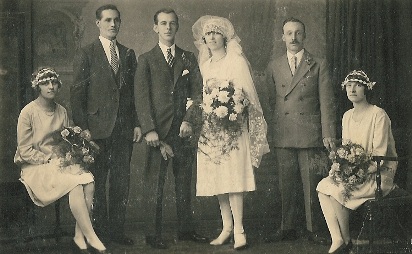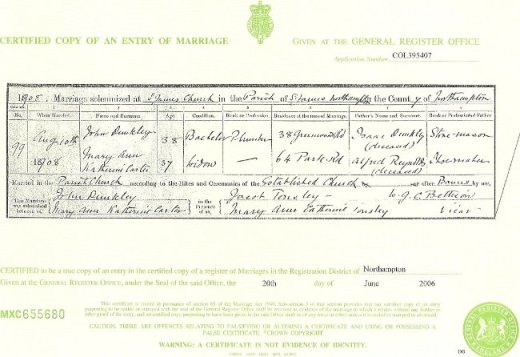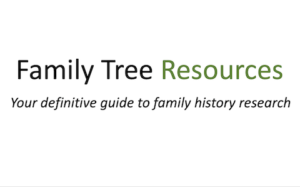A marriage certificate is important when you are conducting family history research because you can prove that a couple you believed married each other actually had, and this can help you to continue your research.
If you find a marriage registration in the GRO Index, and believe that the couple married each other, it is important to obtain a certificate to confirm it.
Two or three marriages are entered on each page in a marriage register.
Although the marriage certificate was given to the married couple, two copies were made; one was kept by the church or register office, the other being sent to the superintendent registrar of the registration district when the entire register became full.
The first information stated on a marriage certificate is the year of the marriage and the venue, such as a church, chapel or register office, and the name of the parish and town or village and the county in which the event occurred.
The registration district can be written on the bottom of the certificate, or in the heading, especially for marriages that took place in earlier years.
A rural district could be very large because, unlike the registration for births and deaths, registration districts for marriages were not split into sub-districts.
Marriage Certificate Details and Format
Entry Number
This column records the entry number from the original marriage register from the venue. The entry number on a marriage certificate will not coincide with the GRO reference in the GRO Index.
Column 1 – When Married
The marriage date is written in this column, with the year written in figures whilst the day and month were written in words, e.g. Twelfth September 1925.
Many marriages took place on Christmas Day in earlier years. A marriage, unlike a birth or death, was registered at the time, so there is no difference between the marriage date and the date of registration.
Column 2 – Name and Surname
The full name of the bride and groom is recorded in this column. Names written here are usually the names they had at the time of their marriage, and may not necessarily be the names the person had at birth. For example, if the mother of the bride or groom had remarried, their child may have taken their stepfather’s name, so could have married under a different surname to the one they had at birth.
It was not uncommon for a person to switch their names round if they had two names, such as Nora Alice instead of Alice Nora. In some circumstances, they may have dropped a name altogether and only used one name when they married.
It is also possible that a bride had been married previously, and used her previous husband’s surname rather than her maiden name.
Column 3 – Age
Between 1837 and 1926, boys could marry when they reached the age of 14, girls at 12, but parental consent was required. Between 1926 to 1969, girls and boys could marry when they reached 16, but parental consent was still required until they reached 21. Since 1969, parental consent is only required if they were under 18.
In earlier centuries, ages were not always recorded in full on the certificate, it only stating whether they were of full age or a minor.
If full age is written in this column, the bride and groom claimed to be over the age of 21. This does not help the family historian much because it makes it more difficult to track down their birth date.
If the term minor was used this meant they had not reached the age of 21 and had parental consent to marry, although sometimes the lady could add a few years on to her true age so she did not need to seek consent.
The groom could shave a few years off his true age, especially if he was many years older than his wife.
A person did not have to prove how old they were unless it was blatantly obvious that they were a lot younger than they claimed to be.
It could also be that the bride or groom did not know how old they were, having no access to their birth certificate or were born before civil registration began, relying on their baptism record, so the marriage certificate could state the wrong age.
Column 4 – Condition
Although the column is headed ‘condition’, the couple’s marital status is written in this column, it very often stating, especially in earlier centuries, whether they were spinster, bachelor, widower or widow. Sometimes, however, either party was not always truthful about their marital status if they wished to hide the fact they had been married previously.
This was especially true in earlier centuries when divorce was looked on as being a great scandal and it cost so much to dissolve a marriage.

Column 5 – Rank and Profession
In earlier certificates of marriage the groom’s occupation was stated, but the women’s occupation was very often not stated even if she worked.
Column 6 – Residence at time of Marriage
A couple’s place of residence may not have been where they were born, and even, in some cases, not their actual abode. It was not uncommon for a couple to live in one parish but regularly worship at a church in a different parish. If one or other of the couple were on the electoral roll of that church, they could marry there even though they lived in a different parish.
Sometimes only the name of the parish is stated in this column, however.
Column 7 – Father’s Name and Surname
If either party was illegitimate the column for father’s name could be blank or the bride or groom could have stated another family member was their father so it sometimes requires further research to prove his identity. I myself have found this to be the case in that my great-great grandfather’s brother, who, being illegitimate, stated that his uncle was his father on his marriage certificate.
It is possible that the bride or groom made up a fictitious name because they did not know who their father was. The column could also have been left blank.
The fact that the father’s name is usually stated can help to further family tree research especially if the lady is a widow or was previously married because it may reveal her maiden name. For example, Mary Ann Katharine Carter was a widow, and declared her father to be Alfred Reynolds. Further research determined that Mary Ann Catherine Reynolds’ birth was registered in January-March 1871 in Northampton District.
If the father is not listed as deceased on the marriage certificate, it does not necessarily mean that he had not died prior to the marriage.
Column 8 – Rank or Profession of Father
The father’s occupation is listed in this column, and this can help tremendously if you have found many people with similar names, and want to ascertain if you have the correct family. Sometimes, especially if the marriage date is close to a census year, you may be able to find the family in the census, and therefore knowing the father’s occupation can help you track the family down.
Other Items
In the section underneath the main part of the certificate, it states ‘married in the (e.g. Parish Church, Baptist Church, The Catholic Church) according to the Rites and Ceremonies of the (Established Church, the Baptists, the Roman Catholics) by _____ after or by me ______. If the marriage took place in the Church of England, the minister is licenced to perform the marriage and only one signature is required because the cleric conducts and registers the marriage.
If the ceremony took place in a Register Office, the ceremony is conducted by the Superintendent Registrar, and the Registrar completes the marriage register, them both signing the document.
If the place of marriage is followed by ‘by certificate’ this usually means that the ceremony was conducted in a non-conformist chapel or a register office.
If ‘by licence’ is stated, this means that the couple did not have to wait the three weeks required by the reading of banns, so could have married the day after giving notice of their intent to marry.
‘After banns’ means that the couple have married in the Church of England. Banns have to be published on three consecutive Sundays prior to the marriage date.
The section then goes on to state ‘This marriage was solemnized between us (signatures of bride and groom). If they were illiterate, a cross was entered, signifying they had made their mark. Because they were illiterate, they did not know if the details recorded were correct, so the information supplied should be verified using other sources.
It then states that it was ‘in the presence of us (at least two witnesses would normally sign here, along with the Registrar or cleric completing the registration). These witnesses may be relatives of either party, and could be relatives previously unknown to you, but could also be family friends, so it is important to check this section of a marriage certificate.
At the bottom of the certificate are the words ‘certified to be a true copy of an entry in the certified copy of a register of Marriages in the Registration District of ___________. Given at the General Register Office, under the seal of the said office, the ____ day of _____.
Marriage Certificate Example:

What Information is on a Marriage Certificate at a Glance:
- Year of marriage
- Venue, Parish and County
- Entry Number in the Register
- Marriage Date
- Bride and groom’s names and surnames
- Ages of both parties
- Condition of both parties
- Rank or Profession of both parties
- Bride and groom’s residences at the marriage date
- Names and surnames of the father of the groom and father of the bride
- Ranks or professions of the groom’s father and the bride’s father
- Signature of the officiant
- Bride and groom’s signatures or marks
- Signatures or marks of witnesses
How to Obtain a Copy of a Marriage Certificate
It is possible to order a certificate from the ONS in Southport after you have found the appropriate registration in the GRO Index. The current price is £11.00.
It is also possible to make a marriage certificate request to the council of the area where you believe the marriage took place by filling in their marriage certificate application form.
To take advantage of this service, however, you do need to know the details of the marriage, such as the name and surname of the bride and groom, and the date and place of the marriage.
